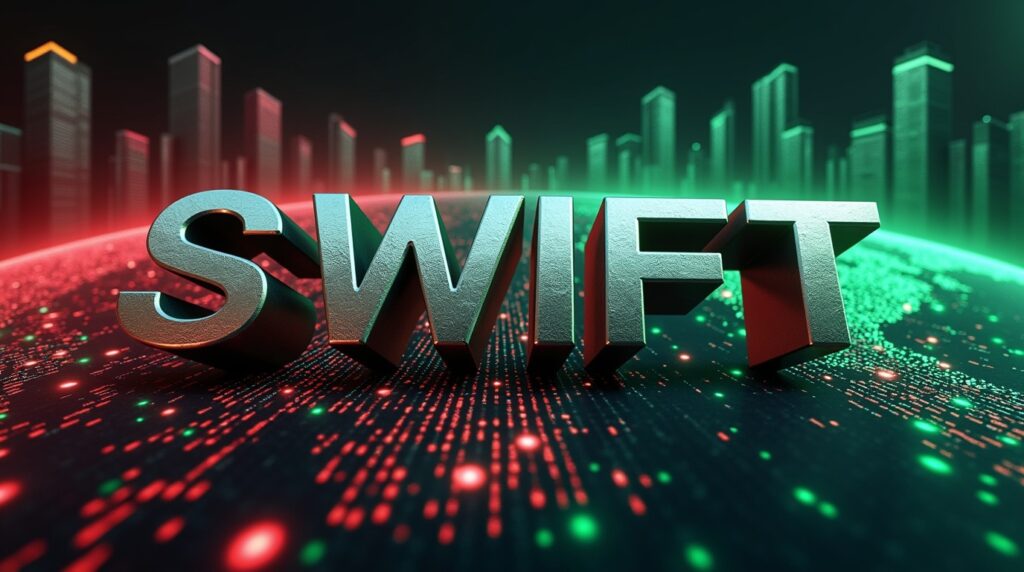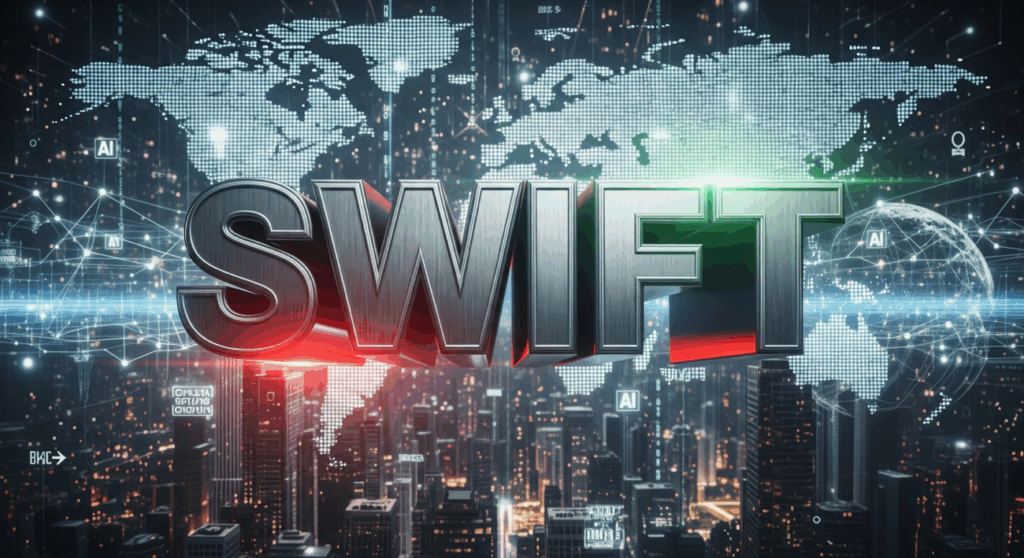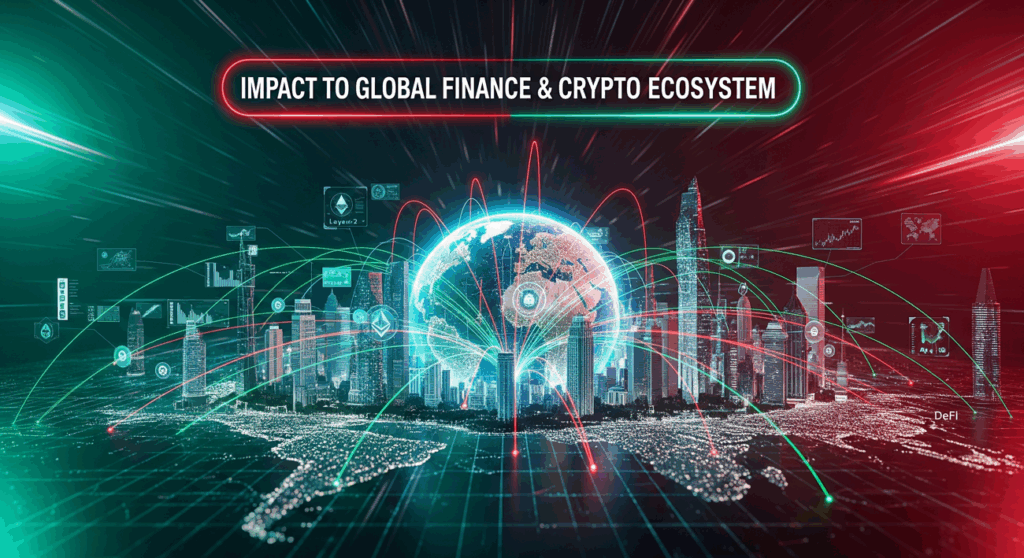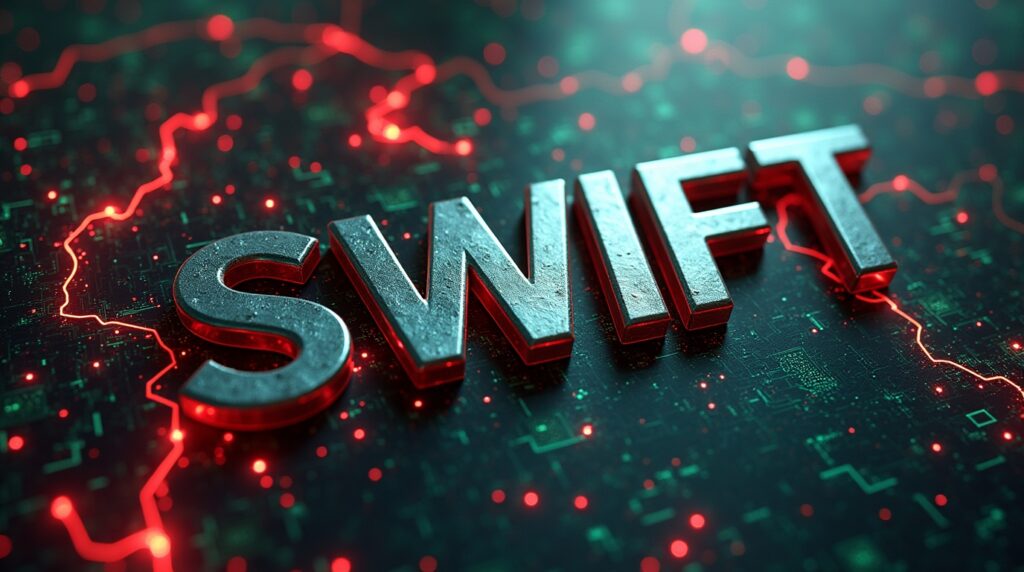The Payment Giant’s Bold Pivot: SWIFT Shocking Move Into the Blockchain World

NO One Should Ignore This Critical SWIFT move
“The Dinosaur Learns to Skateboard”
Picture a six-decade-old industrial titan suddenly showing up at a skate park, struggling to stay upright on a board. It’s an awkward, almost comical image, but therein lies the metaphor for what’s happening with SWIFT. The Story for Worldwide Interbank Financial Telecommunication (SWIFT) has reigned over global payments for over 50 years, doing what no one else could: reliably transferring messages that send money around the world. But now, SWIFT is publicly pivoting into blockchain, attempting not merely to digitize, but to reinvent its role.
This isn’t a casual experiment. For SWIFT, it’s existential. The incentives from fintech, stablecoins, CBDCs, and tokenized finance are not just knocking, they’re battering down the door. What we are witnessing is a potential reshuffling of the global payments order. In this article I’ll walk you through:
- A primer on SWIFT’s legacy, strengths, and vulnerabilities
- What SWIFT’s blockchain pivot really means
- The motives and strategic pressures behind the transition
- How SWIFT is building (and why it chose Linea)
- The ripple effects on global finance, crypto, RWA, and DeFi
- The risks and challenges to execution
- Final thoughts and investment signals
Let’s get started.
1. SWIFT – the Inertial Giant: Legacy, Dominance, and Achilles’ Heel
A Legacy of Ubiquity
For decades, SWIFT has functioned as the global financial messaging backbone. It connects more than 11,000 financial institutions across over 200 countries and territories, passing trillions of dollars in instructions daily (e.g. authorizations, confirmations, reconciliations).
Yet critically: SWIFT does not itself move funds. It is a messaging system, not a settlement rail. When Bank A wants to send money to Bank B, SWIFT carries the message; actual settlement typically flows via correspondent banking, nostro/vostro accounts, and intermediary steps.
This architecture – deep, trusted, universal, became SWIFT’s fortress. But it also masked structural inefficiencies and fragilities that are now exposed.
Cracks in the Foundation
Over time, the very strengths of SWIFT and its deeply embedded network have become liabilities in a fast-evolving world. The primary weaknesses:
- Slow settlement: Even though messages can be near-instant, actual settlement (funds movement) often takes 3–5 business days, especially for cross-border payments. That’s incompatible with the digital age’s demand for real-time rails.
- High fees and friction: Each correspondent bank or intermediary often takes a cut or charges fees. A cross-border transfer may cost $20–$50 or more, which eats into margins, particularly for high-frequency, high-volume corporates.
- Complexity and opacity: The chain of intermediaries introduces points of failure, reconciliation mismatches, and high operational burden.
- Centralization and geopolitical risk: As we saw in 2022, when SWIFT removed Russian banks from the network, the ability to de-bank players at the system level underscores a geopolitical “kill switch.” This inherent centralization is now judged a vulnerability in a more fragmented world.
These flaws, while tolerated for decades, have become existential in the face of blockchain, stablecoins, CBDCs, and fintech pressures.
2. The Tipping Point: Why SWIFT Was Forced to Evolve
SWIFT’s shift is often portrayed as visionary, but a more accurate framing is: reactive evolution. A disruptive wave was closing in, and SWIFT had little choice.
The Stablecoin Surge
Stablecoins: digital assets pegged to fiat (e.g. USDC, USDT), have exploded. Their promise: near-instant, very low-cost settlement. The stablecoin market now exceeds $300 billion+ (Oct2025) in market capitalization. They are increasingly used for payments, trading, settlement, and cross-border flows.
For example, in parts of Southeast Asia, a sizable portion of cross-border SMB payments may bypass banking rails entirely, opting instead for stablecoins to reduce latency and cost. This fuels existential pressure on legacy rails.
To contextualize:
- Assume a trading firm sends 100 international payments of $100,000 each monthly.
- Via SWIFT: $50 × 100 = $5,000 in fees, plus 3–5 days’ settlement risk.
- Via stablecoins: perhaps $0.01 per transfer, total ≈ $1.
- The cost arbitrage is stark, and sustainable.
This isn’t fringe. It’s a structural threat to SWIFT’s core economics.
Fintech & Blockchain Challengers
From Ripple to Stellar to Layer-1 & Layer-2 networks, many blockchain native systems have long pitched themselves as SWIFT killers. They promise:
- Instant settlement
- Minimal fees
- Programmability (smart contracts)
- Transparency
Even if their current market share is small relative to SWIFT’s scale, they have repeatedly demonstrated that the technological model is viable; and politically, many are more nimble and aggressive.
The CBDC Disruption
Central Bank Digital Currencies (CBDCs) represent perhaps the most formidable long-term threat. Over 90% of central banks are researching CBDCs; more than 20 are in pilot phases.
Projects like mBridge (a multilateral CBDC interoperability bridge) aim to allow atomic, peer-to-peer cross-border payments between CBDC systems, bypassing correspondent banking—and potentially SWIFT entirely.
In short: if national banks increasingly settle directly in digital currency, the messaging-only role of SWIFT is at risk of obsolescence.
SWIFT was boxed in.
3. The Shocking Move into Blockchain
On 29 September 2025, SWIFT formally announced it would add a blockchain-based shared ledger to its infrastructure stack.
In its press release:
- SWIFT said the move will let it support real-time, 24/7 cross-border payments using regulated tokenized value (e.g. stablecoins, tokenized deposits).
- Over 30 global financial institutions are collaborating on designing the shared ledger, with ConsenSys as the prototyping partner.
- The design will maintain interoperability with existing systems, embed risk/compliance logic via smart contracts, and allow token flows while preserving SWIFT’s resilience and security.
- The first use case is real-time cross-border payments, but SWIFT’s vision is broader: to enable any regulated tokenized asset to flow over its rails.
This is a radical repositioning: from a purely messaging layer, to a hybrid messaging + settlement ledger operator.
4. The Motive & Strategic Logic
Why is SWIFT doing this? What exactly is being attacked or defended? The motives are multifaceted and deeply strategic.
Defend Core Relevance & Revenue
If SWIFT remains a message-only network, blockchain rails and stablecoins can gradually peel away its utility. By embedding blockchain, SWIFT can:
- Capture part of the settlement revenue (or at least participate in token flows)
- Retain its indispensability to banks by evolving, not ceding ground
- Prevent disintermediation by new entrants
It’s a defensive fortification.
Compete with Stablecoins & Tokenized Assets
SWIFT explicitly frames this as a counter to stablecoins. As stablecoins become more accepted, SWIFT can no longer treat them as fringe. Its new rails can support tokenized value directly, making stablecoins and bank-issued tokens part of its future, not its nemesis.
Bridge TradFi & DeFi
By leveraging blockchain, SWIFT can serve as a bridge between traditional finance (banks, asset managers, sovereigns) and the emerging tokenized economy, such as DeFi, RWA and digital securities. It controls a trusted, regulated nexus that can link the worlds.
Shape the Regulatory Narrative
When SWIFT, a systemically critical institution endorses blockchain settlement, it lends legitimacy to the space. Regulators will take notice. The broader industry can argue that if SWIFT is doing this, blockchain is no longer experimental.
This is a political/market signaling strategy.
Flexibility & Option Value
By not choosing a single native asset, SWIFT retains flexibility. It can adopt or connect to multiple token types (stablecoins, tokenized deposits, CBDCs) as the landscape evolves. It doesn’t lock itself into one bet too early.
5. SWIFT’s Blockchain Tech: Blueprint & Why Linea
What’s under the hood? What architecture is SWIFT building? And why did it choose Linea as the pilot chain?
A Hybrid, Permissioned-Plus Structure
SWIFT’s approach is fusion, not rupture. It is not discarding its legacy rails overnight. Instead:
- Banks will connect to a shared ledger layer in parallel to existing messaging rails
- Migration can be gradual; legacy systems and tokenized rails co-exist
- The new ledger will embed compliance, risk, and controls via smart contract logic
- It will adopt global messaging standards (e.g. ISO 20022) for interoperability
- It is designed to interoperate with external blockchains and token networks, rather than be a siloed “walled garden”
This architecture aims to preserve continuity while enabling blockchain-native settlement.
Why Linea (Ethereum L2)
Multiple reporting sources confirm that SWIFT’s pilot is being built on Linea, an Ethereum Layer 2 owned by ConsenSys (zkEVM architecture).
What makes Linea compelling for SWIFT’s use case?
- zkEVM + privacy
Linea uses zero-knowledge proofs to compress and validate state transitions, providing scalability and confidentiality (i.e. transaction details can remain hidden while proofs validate correctness). That helps satisfy bankers’ demands for privacy alongside on-chain auditability. - Ethereum compatibility and leverage
Building on an Ethereum L2 grants access to the rich smart contract ecosystem, mature tooling, developer base, and linkages to DeFi and token standards. It avoids the cold start problem by piggybacking on Ethereum’s network security and standards. - Modular and flexible
Linea offers modularity, meaning SWIFT can integrate different token types (stablecoins, tokenized bank deposits, CBDCs) without being forced into a monolithic design. - Institutional backing & ecosystem momentum
As a ConsenSys project, Linea has institutional credibility. Its traction is further boosted by initiatives like MetaMask’s $30M rewards program in LINEA tokens, which signals adoption interest. - Performance and cost
While official metrics vary, sources suggest that Linea can reduce transaction costs significantly (e.g. 1/15th of mainnet fees) and handle sizable throughput, sufficient for prototyping large-scale payment rails.
By building atop Linea, SWIFT gets a powerful base: privacy, scalability, developer ecosystem, and optionality.
Interoperability & No Native Token
A key strategic decision: SWIFT is not issuing a native token. It deliberately positions itself as a neutral infrastructure provider, leaving the choice of which tokens to support to commercial banks, central banks, and regulators.
SWIFT has also announced work on integration with Chainlink’s Cross-Chain Interoperability Protocol (CCIP), signaling that it intends to bridge its ledger with other blockchains and token systems.
This neutrality is vital: it helps maintain SWIFT’s status as a trusted, agnostic node rather than competing directly with native chains.
6. Impact to Global Finance & Crypto Ecosystem
SWIFT’s shift is not incremental. It threatens to rewire the architecture of global payments and thereby every layer above and below it. Below are some of the most consequential impacts.
Real-Time, Always-On Cross-Border Payments
If SWIFT’s shared ledger succeeds, cross-border payments may become instant, 24/7, reliably final, rather than delayed by banking hours, weekends, or time-zone constraints. Corporates, banks, funds, and individuals could all benefit from improved working capital, reduced FX risk, and more efficient liquidity management.
Cost Compression & Efficiency Gains
By eliminating multiple intermediaries and automating reconciliation, transaction costs can fall dramatically. For banks, this means higher margins on cross-border rails. For corporate users, lower friction in global trade.
Revalorization of Ethereum & Layer-2 Networks
If SWIFT routes even a small fraction of its messaging volume (estimated at $150 trillion annually) onto L2 rails like Linea, that could produce an explosive demand shift for those networks.
In other words: the L2 ecosystem may see a structural demand inflection when large institutional flows become native to it.
Legitimacy and Institutional Adoption
SWIFT’s endorsement could serve as a major signal to conservative institutions that blockchain settlement is not fringe technology, but foundational infrastructure. This could accelerate institutional capital flows into tokenized assets, stablecoins, RWA, and DeFi infrastructure projects.
Interplay with CBDCs & Tokenized Assets
SWIFT’s ledger could serve as a connective fabric between CBDCs, tokenized real-world assets (RWA), and private digital money systems. For example:
- A bank could issue a tokenized deposit on SWIFT’s ledger
- CBDCs could be bridged into or out of it
- Tokenized securities, debt, or trade finance assets could settle via the same rails
This convergence would blur the lines between traditional finance and on-chain finance.
Competitive Reset for Payment Networks
SWIFT’s pivot recalibrates competition. Ripple (XRP), Stellar, Hedera, and private rails are no longer just challengers, they are complementary or competing rails. For projects built around payment-specific rails, SWIFT’s new rails may validate their mission but also raise the bar for scale, compliance, and institutional integration.
Regional / Emerging Market Impacts
Emerging markets and corridor flows may benefit disproportionately. In corridors where banking infrastructure is uneven or expensive, cheaper, instant rails could transform remittances, trade finance, supply chain payments, and micro-exports.

7. Risk and Challenges: The Dark Side of the Pivot
While the opportunity is immense, the path is littered with risk. Let’s be clear-eyed.
Legal Finality & Settlement Law
Blockchain entries are technical records. But in traditional finance, legal settlement is a legal concept: once a payment is “final,” it can’t be reversed or clawed back in courts. Whether a token transfer on a shared ledger carries the same legal finality across jurisdictions is unsettled.
As SWIFT’s own innovation officers have flagged: settlement is a legal concept, not a purely technical one.
Regulatory Uncertainty & Jurisdictional Divergence
While SWIFT signals legitimacy, tokenized money and digital assets remain under patchwork regulation. For example:
- The U.S. continues to debate stablecoin oversight, securities laws, and CFTC/SEC jurisdiction
- The EU’s MiCA regime is still rolling out
- Asia-Pacific markets diverge (Singapore, Hong Kong, Japan are more progressive; others lag)
Any misalignment across jurisdictions (AML/KYC, sanctions, tax, securities) can derail adoption.
Integration Complexity & Legacy Drag
Merging a 50-year incumbent system with blockchain rails is like installing a sports car engine inside a classic car: the mechanical, systems, and operational risk is enormous. Software bugs, interface mismatches, timing mismatches, data mismatches etc..all are danger points.
Cyber & Operational Security
While blockchains are relatively secure, the surrounding infrastructure (wallet APIs, key management, routers, nodes) is vulnerable. A breach or glitch could generate catastrophic trust and financial damage.
Competition & Innovation Arms Race
SWIFT is joining a fierce space. Ripple, Stellar, Hedera, private rails (eg. JPMorgan’s in-house rails), and CBDC interoperability platforms won’t sit still. For SWIFT, staying ahead on features, performance, compliance, and liquidity is a perpetual race.
Adoption Friction & Network Effects
Banks, particularly small or regional ones, may struggle to upgrade or adopt. The network effect advantage SWIFT currently has might become a dilution risk if the transition is gradual and uneven.
Token Liquidity & Market Depth
Even if SWIFT supports multiple tokens, ensuring deep liquidity sufficient for large institutional flows is nontrivial. Without deep markets, slippage, fragmentation, and arbitrage risk will arise.
8. Investment Signals: How to Play (and What to Watch)
For a normal person and investors of crypto, RWA, AI, SWIFT’s pivot is a treasure trove of clues. Here are actionable signals:
Signal 1: Explosion in L2 Ecosystem Demand
If SWIFT routes any significant traffic to L2s like Linea, Arbitrum, or Optimism, the valuation of those networks (and tokenized infrastructure) could reprice upward.
- Speculative play: Accumulate L2-native tokens (especially if Linea announces a token).
- Core play: Hold Ethereum (ETH), it remains the settlement and security base for many L2s.
- Infrastructure play: Projects that build tooling, middleware, cross-chain bridges, oracles, or wallets for L2s may experience meteoric growth.
Signal 2: Stablecoins & Tokenized Banking Will Be Revalued
SWIFT’s adoption confers legitimacy on regulated stablecoins and tokenized deposits as core settlement assets.
- Buy into regulated, transparent stablecoins (e.g. USDC)
- Bet on infrastructure partners: Chainlink’s involvement (via CCIP) is a clear hint.
- Monitor tokenization platforms for bonds, funds, trade finance, etc., especially those targeting institutional adoption.
Signal 3: Digital-First Banks May Get a “Quantum Leap”
Banks in SWIFT’s pilot get to trim cross-border costs by possibly 50–70% or more. That could directly feed into profit margins and valuation multiples.
- Invest in banks that are early adopters (e.g. JPMorgan, Bank of America, BNP Paribas, BNY Mellon)
- Avoid laggards in the traditional banking sector who decline to modernize
Signal 4: Payment & Cross-Border Projects Must Recalibrate
For projects like Ripple (XRP), Stellar, or other niche corridor rails:
- SWIFT’s entry is both validation and competition
- Competitive dynamics will push them to integrate or interoperate rather than simply compete
- Partnerships, bridge strategies, and compliance will become critical differentiators
Signal 5: Regulatory Clarity & Compliance Will Be a Choke Point
As SWIFT enters, regulators globally are forced to respond.
- Projects and protocols with strong compliance orientation (auditability, KYC, reporting) will be favored
- The shift will accelerate clarity and rulemaking, the regulated will outperform the unregulated
Watch Points & Tactical Moves
- Watch for Linea token announcement (if any)
- Monitor banks joining the pilot for lead indicators
- Observe flow volumes on early pilot transactions
- Track regulatory changes in U.S., EU, and Asia
- Evaluate bridge & cross-chain protocols (e.g. CCIP)
- Stay alert to RWA tokenization platforms integrating into SWIFT rails
9. The “Three Kingdoms” Future: Multipolar Architecture
It’s unlikely a single network will dominate. A more plausible outcome is coexistence, complementarity, and competition. This may evolve into a “Three Kingdoms” model:
- SWIFT’s Consortium Chain
Purpose: high-value, regulated, bank-to-bank settlement, especially for large-value and legacy flows. - Fintech / Payment Rail Networks (Ripple, Stellar, etc.)
Focused on SME, remittances, consumer rails, corridor-specific flows, settlement corridors where agility matters. - Public Blockchains, DeFi & Tokenized Finance
The open, permissionless layer that powers composability, innovation, and programmable finance in high-growth use cases.
The key connective element will be interoperability protocols (e.g. CCIP, cross-chain bridges) that allow seamless movement across these kingdoms.
10. Conclusion
SWIFT’s pivot into blockchain is more than symbolic. It is a calculated, high-stakes defense and adaptation strategy signaling that the next 10 years in finance belong to tokenization and real-time digital rails.
For the bold, the curious, the investor-minded, this moment is a rare inflection. The dinosaur may have started skateboarding, but it’s also building the skatepark of tomorrow.
Betting on any single “winner” is risky. Instead, the clearest pathway to alpha lies in diversification across infrastructure, token rails, compliance tools, and tokenized assets, and in positioning early.



